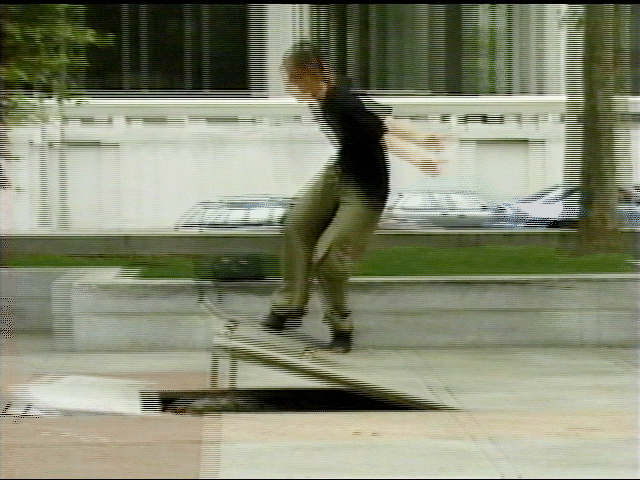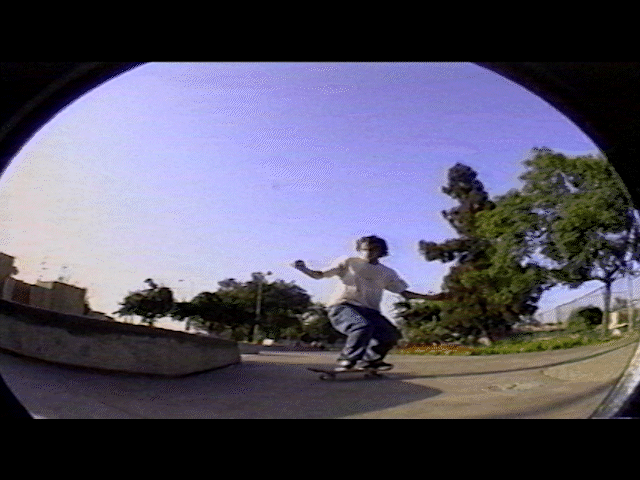top of page

About the transfer
Since the birth of skate videos in the 1980s until the invention of DVD around the turn of the millennium, VHS tape was the only format skateboard videos were widely released on. Unless you saw the premiere in a movie theater or were lucky enough to own a projector, these films were viewed on a 4x3 cathode ray tube (CRT) television connected to a VCR. Once DVD and digital displays became available some companies did re-release their films for modern displays but most have not and to this day the majority of skate videos have only ever seen a VHS release. However because of licensing issues and censorship these re-releases are forced to have differences from the original release. These changes can be small and go unnoticed or are more significant like completely different music tracks. So although DVD is widely agreed to have a cleaner image than VHS, these re-releases are incomplete and do not fully preserve the original film.
VHS does have serious limitations. It is a low resolution, interlaced format that greatly benefited from a CRT's inherent blurriness and small size (relative to today's displays). When viewed on a modern high resolution flat-panel display the limitations of this format become fully visible. VHS is also very delicate; the magnetic tape is easily damaged, resulting in lost video or audio. Even brand-new, un played tapes can have glitches. VHS tapes also do not store well and will degrade over time. All of this makes getting the best possible image quality out of the format a challenge. It wasn't designed for or ever intended to be seen on the high resolution displays of today so translating an analog tape to a digital file is not straightforward and requires more work than most people would bother with or even think is necessary.
Which is why these videos have floated around the Internet for years with a list of issues:
-
They are often in pieces or incomplete.
-
Audio is misaligned, or entire music tracks are missing due to licensing issues.
-
Low resolutions that result in blocky compression artifacts and image quality loss.
-
De-interlacing that was done either improperly or not at all, resulting in combing artifacts and ghosting.
-
Efforts to 'remaster' or improve the image quality or frame rate that do more harm than good.
-
The image is stretched to the wrong aspect ratio.
-
Watermarks.



Combing artifacts
Low resoultion
Incorrect aspect ratio
In some cases, even the companies that originally produced these films will have official uploads online that suffer from the same issues. This is not always the case, and there are good remasters out there, but more often than not they are less than ideal. This poor quality does not do justice to the original aesthetic of this media and this issue is so prevalent you might think these videos always looked bad, and it's just nostalgia distorting your memory into thinking they looked better.
Thankfully, there is a better way.
The goal of this project is to create the highest possible quality captures of analog 480i 4:3 59.94hz VHS and convert them to a digital 4K (2160p) 16:9 29.97fps file that is easily stream-able but with a high enough bit rate that there is no visible image quality loss.
Every video uploaded for this project was created from a brand new analog-to-digital transfer using original VHS tapes. The tapes are captured using a high-end, new-old-stock SVHS VCR that has only ever been used for these captures. The VCR sends an S-Video signal to a analog-to-digital converter that maintains the native video signal of 480i 59.94hz. This converter also has time base correction, which eliminates dropped frames during capture and keeps the video and audio signal in sync. That signal is then captured using a lossless video codec and uncompressed audio through a capture card that is capable of recording the native resolution and frame rate. That capture is then deinterlaced and scaled in software and exported as a 4K (2160p) H.264 MP4 file that is optimized for viewing on the web.
When viewed side by side, the raw capture and compressed H.264 files are virtually indistinguishable:


Raw capture
H.264 compression
All of these attempts at preservation of the original source material can also have downsides. Although efforts have been made to maintain the highest possible quality, VHS is still a low-res, interlaced analog format. No matter how advanced the capture process is, this is an ancient technology and should be viewed in the context of when it was released. High accuracy with no image quality loss means that the imperfections of the format are also recorded. The capture process is 'open matte,' meaning no visual information is lost, but this is also why you may often see noise at the bottom of the screen. This analog noise would normally be hidden in the overscan of a CRT, but it is fully visible on a modern display. It should also be noted that any other glitches in the image are caused by damage to the tape itself and are not from the capture process. These issues can only be fixed with the capture of an additional tape that does not suffer from the same damage.
Recently, AI has made substantial progress in upscaling low-res images and video. However, based on the current software available, AI was not used in this project. AI video upscalers, like those from Topaz Labs, are designed to scale HD footage to 4K, not SD to 4K. The result of every scaler tested for this project was a "posterized" image where blocks of pixels are turned into blobs of color and generally degrade more than improve the overall image. Detail-preserving upscalers create an obvious halo around highlights of such low-resolution images. Current attempts to de-noise only seem to smear the overall image with significant detail loss. A clean scale is, for now at least, the best way to preserve 480i media.
FAQ
"What about DVDs? Aren't they better quality?"
DVD and VHS actually share the same line resolution but the digital format does not suffer from the same analog issues and the result is a noticeably cleaner image. DVD re-releases were not used for this project because often the publisher is forced to make changes, like replacing entire music tracks due to licensing issues or removing images due to censorship, making the DVD versions incomplete.
...
"Why not 1080p? Wouldn't it be a smaller file size and look exactly the same?"
Although 4K resolution wasn't adopted as quickly as High Definition was during the transition from Standard Definition, today it is widely used as the new video standard in display technology which is why it was for this project. However, even state-of-the-art TVs cannot scale video in real time as well as software can given all the time it needs. By not relying on the display to scale a 1080p file to a 4K window, the end result is a much sharper image.
...
"Are these videos AI-upscaled or frame-rate-increased?"
Several of the newest and most popular AI video upscalers were tested for this project. But as these programs were designed more for upscaling HD footage to 4K, they do not perform nearly as well with SD footage. AI currently does more harm than good to SD media. However, the benefit of capturing these videos at their native resolution means that as new methods for upscaling come along, the work put into this project can be reused without needing to re-capture the tapes with no image quality loss.
...
"Is this piracy?"
Yes, I do not own the rights to any of these videos. However, all of the videos used for this project are made from out-of-print VHS tapes that are 15 - 30 years old. In order to re-release these videos unchanged and in their entirety, the publisher would be forced to pay substantial music licensing fees that make it nearly impossible for a “complete” DVD re-release to be financially viable, and because of this the VHS tape is the only truly complete version that will ever be released. For this reason, it unfortunately becomes a necessity to pirate these films in order to fully preserve them.
*This site is not for profit, and all videos are distributed freely,
but if you are a copyright owner and would like your video taken down, please visit the Contact page.
...
"What about the Doomsday Duplicator project?"
The latest development in analog-to-digital video capture is the Doomsday Duplicator project. The process involves completely bypassing the analog video signal of a VCR by capturing the raw data directly from the RF signal on the magnetic tape. In theory, this is the cleanest recording possible for VHS, but it has a couple of downsides. The improvement in image clarity is minimal but the file size of the capture increases by roughly 10x compared to the method used for this project, which makes storage very, very expensive. Bypassing the analog video signal also removes a large part of the original aesthetic of these films. Sharper also means enhancing imperfections. The inherent blurriness of analog video does a lot to hide the flaws of low-res interlaced media so it's debatable whether the Doomsday Duplicator is subjectively better than analog video capture.
*If you have hands-on experience with Doomsday and are interested in connecting on this project, please visit the Contact page.
Do you own a tape that's not on this site?
Or a tape that is in better condition than the one in this collection?
Please visit the Contact page
bottom of page